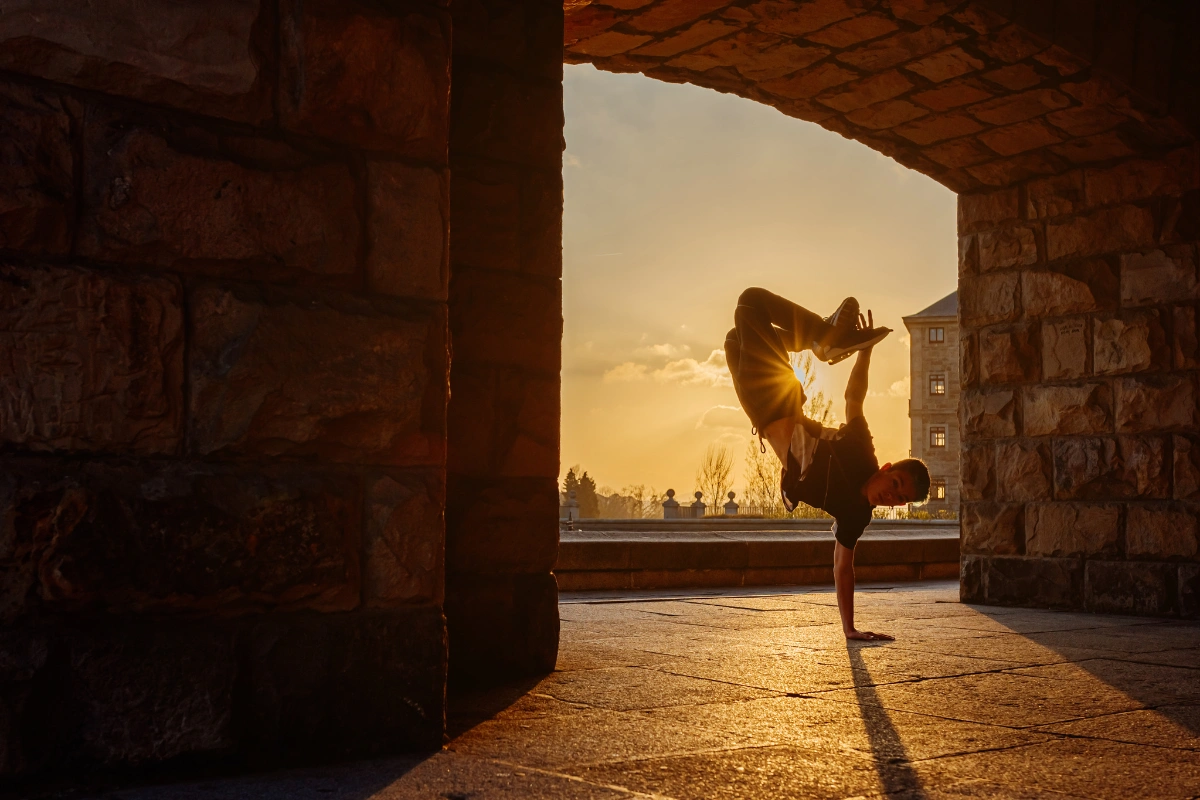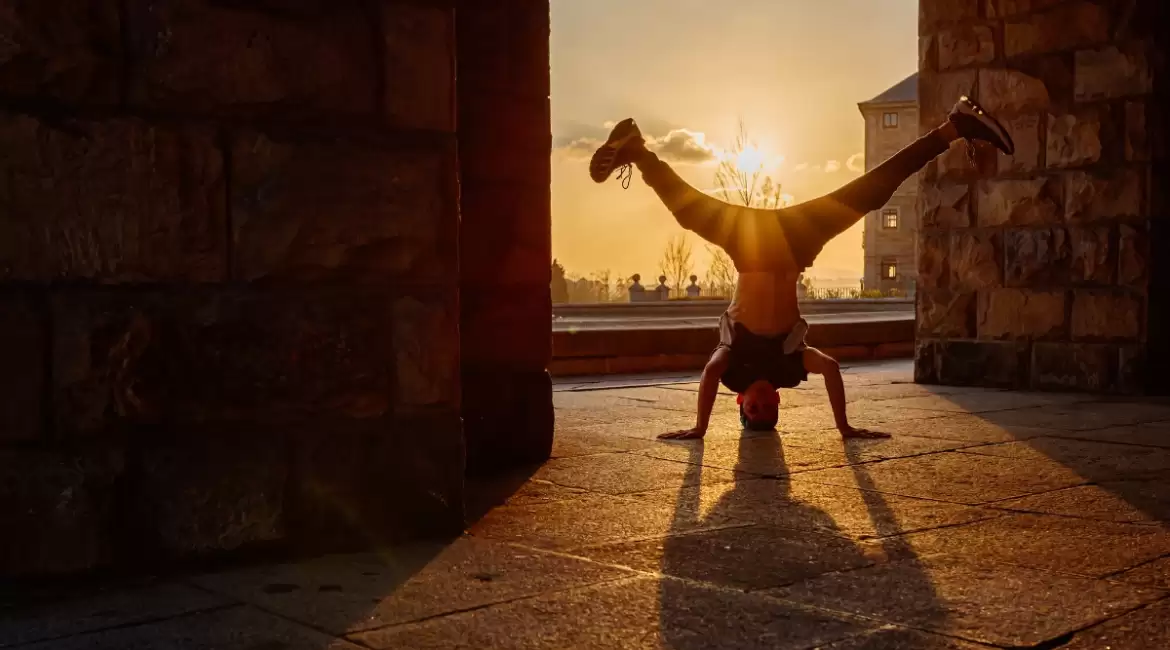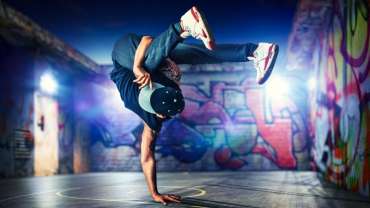What is breakdancing? Breakdancing, an art form born from the streets and rooted in creativity and athleticism, demands not only skill and passion but also the right gear to enhance performance and ensure safety. Whether you’re a novice exploring the basics or an experienced breaker pushing the boundaries of movement, understanding the essential breakdance gear is key to elevating your practice and expression.
At its core, breakdancing thrives on dynamic movements that challenge the body’s limits, from intricate footwork to gravity-defying spins and power moves that test agility and strength. Amidst these feats, the choice of gear becomes pivotal in supporting both performance excellence and injury prevention.
From footwear that offers traction and flexibility to clothing that facilitates fluid movement, each piece of breakdance gear serves a distinct purpose. Protective equipment such as kneepads, elbow pads, and wrist guards becomes indispensable, safeguarding joints during demanding maneuvers. Headgear, whether it’s a beanie, cap, or helmet, protects against impacts during freezes and spins, ensuring both safety and comfort.
Accessories like portable speakers for music and hair clips for managing long hair contribute to the environment and focus necessary for effective practice. Even considerations such as portable mats or dance floors play a role in providing a consistent surface for training, minimizing the risk of injury and enhancing performance consistency.
In this comprehensive guide, we delve into the essential breakdance gear and accessories, exploring their functionalities, benefits, and the considerations that guide their selection. Whether you’re preparing for a competition, honing your skills in a studio, or practicing in unconventional spaces, equipping yourself with the right gear not only enhances your ability to perform but also reflects your dedication to the artistry and culture of breakdancing.
Join us as we uncover the tools and techniques that empower breakers worldwide to push boundaries, express their unique styles, and elevate the art of breakdancing to new heights.

Do you need breakdance gear?
Yes and no.
When you’re just starting out in dancing, breakdance gear isn’t essential. All you really need is yourself and some good music to practice to. Focus on mastering toprocks, footwork, and basic freezes. Comfortable clothing and shoes are sufficient for getting started.
However, as you progress in your breaking skills and begin exploring different moves, you’ll find that having the right gear can significantly enhance your performance on the dance floor. Depending on the type of moves you’re practicing, you may find kneepads, elbow pads, wrist guards, headgear, or specialized clothing beneficial.
Breakdance gear serves not only functional purposes but also acts as a form of personal expression, reflecting one’s unique style or cultural influences.
While breakdance gear can indeed be useful, it’s important to remember that it’s just a tool. What truly sets you apart is your skill and passion for breaking. That said, wearing something you feel good in can boost your confidence and, consequently, improve your dance performance.

Shoes
When it comes to footwear for breakdancing, the right shoes can make a significant difference in your performance. It’s crucial to choose shoes that provide adequate support for your feet while remaining flexible and lightweight. Many b-boys and b-girls opt for shoes with thin soles, which offer better traction on the dance floor. Ultimately, comfort is key—you should feel at ease and confident in your shoes.
The most popular choices among breakers are sneakers or running shoes. Brand preferences often reflect individual style, with Nike, Adidas, Puma, Vans, Converse, Reebok, and New Balance being favored brands. Some dancers prefer shoes with vibrant colors and unique designs, using them as a means of personal expression. Indeed, your choice of footwear can speak volumes about your personality and artistic flair.
In summary, while functionality and comfort are paramount in breakdance footwear, the style and individuality expressed through your shoes can also play a significant role in your overall performance and presence on the dance floor.
Clothing
When considering clothing for breakdancing, comfort and freedom of movement are essential. B-boys often opt for loose-fitting attire that allows unrestricted mobility, which can enhance the visual impact of certain movements. It’s advisable to avoid fabrics that retain moisture, like some types of cotton shirts, as they can become uncomfortable during intense sessions.
The choice of clothing becomes crucial during power moves, particularly those involving spinning on the back or shoulders such as the backspin or windmill. Garments that are too thin can cause discomfort and abrasions, especially on the back and shoulders. Additionally, the material of your shirt affects its friction against the floor, influencing your ability to execute spins smoothly. Many breakers prefer windbreakers or special mocknecks/crewnecks for this reason, as they minimize friction and support fluid movement.
What are power moves? Power moves in breakdancing refer to dynamic and acrobatic maneuvers that emphasize strength, speed, and momentum. These moves typically involve rotational motions and often require significant physical exertion and control. Power moves are characterized by their explosive nature and the ability to showcase a breaker’s athleticism and technical skill. Some common power moves include windmills, flares, airflares, 1990s, and halos, among others. These moves are not only visually impressive but also require a high level of strength, flexibility, and coordination to execute smoothly and with precision. Power moves are a prominent aspect of breakdancing competitions, where breakers showcase their ability to perform these challenging maneuvers as part of their routines.
Furthermore, your clothing is a means of expressing your personality and connection to the culture of breakdancing. Unique colors, prints, or designs can distinguish you and convey your attitude towards the art form. Your outfit serves not only practical purposes but also acts as a statement of identity on the dance floor.

Headgear
Headgear is crucial in breakdancing, particularly during freezes and power moves where your head frequently contacts the ground. Protecting your head is essential, especially during spins like the windmill, halo, or headspins, as repeated impact without proper protection can lead to injuries or even hair loss. Therefore, it’s important to prioritize safety.
When selecting headgear, breakers have several options to consider. Beanies and caps provide minimal protection while maintaining a casual and stylish appearance. For enhanced safety, some dancers opt for helmets, which offer more robust protection against impacts. The choice between these options often depends on personal preference, comfort, and the specific moves being practiced or performed.
Ultimately, wearing appropriate headgear not only safeguards your well-being but also ensures you can focus confidently on your technique and performance without concerns about potential injuries.
Beanie
The beanie holds a special place as the favored headgear among many b-boys and b-girls in the breakdancing community. Specifically designed for breaking, these beanies feature materials that offer both protection and comfort during maneuvers like headspins and headslides. High-quality breaking beanies often incorporate padding for enhanced head protection and include a secure strap mechanism to prevent them from slipping off during spins—a crucial consideration to maintain uninterrupted focus and safety during routines.
Among the standout options is the premium Spin Cap from Spincontrol, acclaimed within the community for its design tailored by breakers for breakers. This beanie exemplifies the ideal blend of functionality and style, crafted to meet the specific demands of breakdancing with durable materials and thoughtful details that prioritize both performance and protection.
Choosing the right beanie can significantly enhance a breaker’s confidence and performance, ensuring they can execute demanding moves with comfort and security, all while expressing their individual style within the vibrant culture of breakdancing.
Cap
Another popular choice among b-boys is the cap, which offers a distinct alternative to beanies for head protection during breakdancing. Specifically designed for this purpose, breakdance caps are typically constructed from breathable mesh materials that provide ventilation and comfort while safeguarding the head during headspins and other floor maneuvers. It’s important to note that caps chosen for breaking should avoid having a button on the top, as this can cause discomfort or interference during spins.
The functionality of breakdance caps lies in their ability to combine protective features with practicality, allowing dancers to maintain focus on their routines without compromising on safety or style. By selecting caps tailored for breaking, dancers can ensure they have the necessary headgear to support their performance while aligning with their personal preferences within the diverse realm of breakdancing attire.

Headspin helmet
A headspin helmet is a noticeable choice among some b-boys, offering distinct advantages despite occasionally being perceived as less stylish. These helmets play a significant role in facilitating the learning and execution of headspins. Unlike beanies or caps, helmets provide a flat and stable surface that aids in maintaining balance and ease of rotation during spins. Importantly, they also eliminate concerns about hair damage or style interference, making them a practical choice for breakers focused on performance and safety.
When selecting a headspin helmet, it’s recommended to opt for models designed for activities like skateboarding, which typically feature durable construction and a smooth, flat surface ideal for spinning. This ensures optimal functionality without compromising on comfort or protective benefits.
While helmets may differ aesthetically from traditional headgear like beanies or caps, their role in enhancing spinning ability and safeguarding against injury underscores their value within the breakdancing community, particularly for those prioritizing skill development and performance consistency.
Protective gear
Protective gear plays a crucial role in breakdancing due to its physically demanding nature, which puts significant strain on joints, particularly knees, wrists, and elbows. To mitigate the risk of injuries, many breakers rely on specialized protective equipment such as kneepads, elbow pads, and wrist guards.
Kneepads are essential for cushioning impacts and providing stability during floorwork, where knees often bear the brunt of the body’s weight and friction. Elbow pads offer similar protection, shielding elbows from abrasions and impacts during moves that involve supporting body weight on the elbows. Wrist guards are designed to support and protect wrists from strains and impacts, particularly important during maneuvers that involve weight-bearing on the hands and wrists.
By incorporating these protective measures, breakers can minimize the risk of joint injuries and maintain performance consistency, allowing them to focus on perfecting their techniques and artistic expression without compromising their physical well-being. The choice of protective gear often reflects individual preferences and the specific demands of different breaking styles, ensuring both safety and comfort throughout intensive practice sessions and performances.
Kneepads
Kneepads play a vital role in breakdancing due to the physical strain certain moves place on the knees, making knee injuries a common concern among breakers. Moves that involve frequent knee contact with the ground, such as sweeps and slides, increase the risk of abrasions and impact injuries. To mitigate these risks, many b-boys use kneepads to safeguard their knees, particularly during practice sessions.
Kneepads are essential for providing cushioning and protection against impacts. They serve as a buffer, absorbing shock and reducing the strain on the knees when performing floorwork. Specialized kneepads designed for breaking offer optimal comfort and protection, although some models intended for skating can also be suitable. It’s important to select kneepads that fit securely without restricting circulation, ensuring comfort and effectiveness during extended use.
What is floorwork? Floorwork in breakdancing refers to a style of movement and technique that involves performing maneuvers and transitions directly on the floor. Unlike standing or upright moves, floorwork emphasizes close interaction with the ground, requiring agility, flexibility, and creativity to navigate smoothly. Breakers use various elements of floorwork to create intricate sequences that often include spins, rolls, slides, and controlled movements using different parts of the body, such as hands, elbows, knees, and feet.
Floorwork is integral to breakdancing routines as it allows breakers to explore different levels of movement and expressiveness. It often serves as a foundational component that connects different segments of a performance, adding fluidity and dynamic transitions between upright moves and freezes. Floorwork techniques vary widely depending on individual style and creativity, with breakers developing unique combinations and sequences that showcase their skill and personal flair.
By incorporating kneepads into their practice routines, breakers can minimize the likelihood of knee injuries and maintain their ability to perform demanding moves with confidence. Choosing the right kneepad not only enhances safety but also supports continuous improvement and mastery of breakdancing techniques, enabling dancers to focus on their artistry without concerns about physical discomfort or injury.
Elbow pads
Elbow pads are essential equipment for breakdancers, particularly when practicing moves that involve landing, spinning, or sliding on the elbows, such as elbow freezes. These pads provide crucial protection against impact and friction, significantly reducing the risk of injuries and long-term wear on the elbows.
The repetitive nature of breakdancing moves that involve supporting body weight on the elbows can lead to abrasions, bruises, or even more serious joint issues over time. Elbow pads serve as a cushioning barrier, absorbing shocks and preventing direct contact with hard surfaces, thus preserving the health and integrity of the elbows.
Choosing the right elbow pads is important for ensuring comfort and effectiveness during practice sessions. Look for pads that offer adequate padding and a secure fit without restricting movement. Many breakers prefer elbow pads designed specifically for breakdancing or those used in other sports like skateboarding, as they are typically designed to withstand impact while allowing freedom of movement.
By incorporating elbow pads into their practice routines, breakdancers can protect their elbows from injuries, maintain their performance consistency, and prolong their ability to execute challenging moves with confidence and safety.
Wrist guards
Wrist guards are indispensable for breakdancers, particularly when performing power moves and freezes that place significant strain on the wrists, such as flares, jackhammers, swipes, or turtle freezes. The repetitive impact and weight-bearing on the wrists during these maneuvers can lead to discomfort and potential injuries over time.
Wrist guards offer essential support and protection by stabilizing the wrists and reducing the strain caused by sudden impacts or prolonged pressure. They help distribute the force evenly across the wrist joint, minimizing the risk of strains, sprains, or more serious injuries. For breakers, especially those focused on advancing their skills and mastering intricate moves, wrist guards are crucial for maintaining performance consistency and preventing setbacks due to wrist discomfort or injury.
Choosing the right wrist guards is key to ensuring effectiveness and comfort during practice sessions and performances. There are various types available, ranging from specialized wrist guards designed specifically for breakdancing to alternatives like gymnastics wrist wraps, which offer similar support and flexibility. It’s advisable to select wrist guards that fit securely and align with your personal style preferences, ensuring optimal protection without compromising your movement or technique.
By incorporating wrist guards into their training regimen, breakdancers can safeguard their wrists, enhance their performance capabilities, and sustain long-term enjoyment and progression in the art of breakdancing.

Accessories
When dancing outdoors, having portable speakers is essential to ensure you have music accompanying your movements. Music is integral to the rhythm and expression of dance. It’s advisable to select speakers with a reliable battery life, as outdoor locations often lack accessible electricity.
For dancers with long hair, using a hair clip is advisable to keep hair away from the face during routines, ensuring clear vision and preventing distractions.
Considering the environment for practice, using a portable mat or dance floor can be beneficial. Many breakers utilize portable dance floors in settings like gardens or living rooms to create a smooth and consistent surface for practice sessions. These mats not only enhance the experience by providing a suitable surface but also contribute to injury prevention by reducing the risk of slips or uneven footing.
Choosing to invest in these accessories demonstrates a commitment to optimizing practice conditions and enhancing performance quality. Whether it’s ensuring music availability, managing hair, or setting up a conducive practice area, each accessory plays a role in supporting a dedicated approach to breakdancing and maximizing enjoyment and safety during training.
Summary
Breakdancing, an art form rooted in urban culture and celebrated for its dynamic movements and expressive style, necessitates a thoughtful selection of gear to maximize both performance and safety. Whether you’re just beginning your journey into the world of breaking or you’re a seasoned practitioner refining your craft, the right gear plays a pivotal role in shaping your experience and capabilities.
Beyond the basics, protective gear such as kneepads, elbow pads, and wrist guards becomes indispensable for minimizing the risk of injuries during floorwork, freezes, and power moves that exert tremendous strain on joints and limbs. Headgear—whether it’s a beanie for style and head protection or a helmet for robust impact resistance—ensures safety during spins and falls, allowing breakers to push their limits without compromising their well-being.
In addition to safety considerations, accessories like portable speakers for music and hair clips for managing long hair contribute to the ambiance and focus required for effective practice sessions. Portable mats or dance floors provide a consistent, supportive surface, reducing the risk of slips and injuries while promoting sustained improvement in technique and performance.
This comprehensive guide explores each facet of breakdance gear, detailing its functionalities, benefits, and the nuances involved in selecting the right equipment for different practice environments and personal preferences. By equipping yourself with the appropriate gear, you not only enhance your ability to perform but also deepen your connection to the culture and community of breakdancing, where style, innovation, and technical prowess converge to define this vibrant art form.
Author Profile
Latest entries
 Break DanceOctober 20, 2024Master the Cha-Cha Slide
Break DanceOctober 20, 2024Master the Cha-Cha Slide Break DanceOctober 20, 2024The Ultimate Guide to Disco Dance
Break DanceOctober 20, 2024The Ultimate Guide to Disco Dance Break DanceOctober 20, 2024The Role of Creativity in the Sportification of Breakdance
Break DanceOctober 20, 2024The Role of Creativity in the Sportification of Breakdance Break DanceOctober 20, 202412 Popular Dance Styles
Break DanceOctober 20, 202412 Popular Dance Styles






Leave a reply